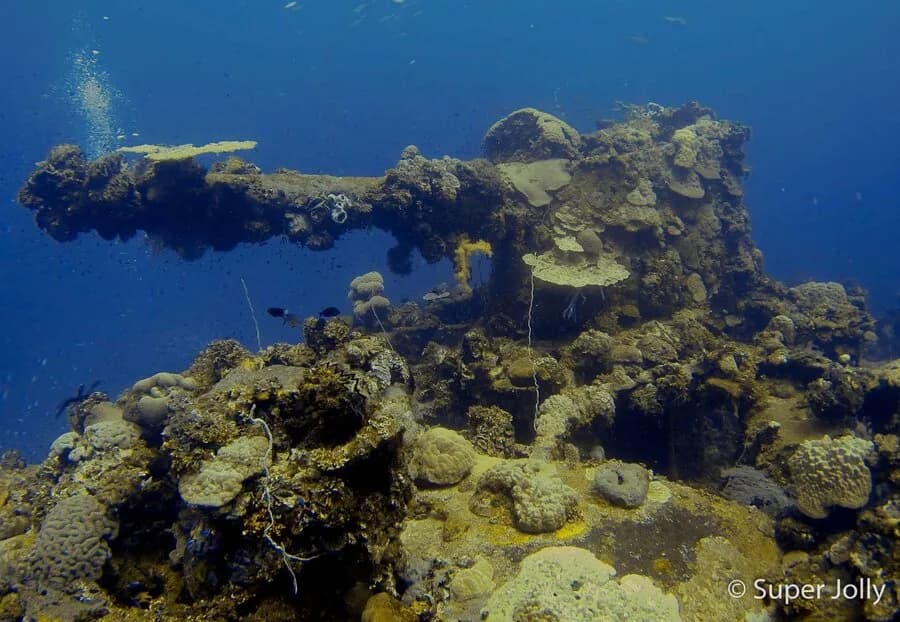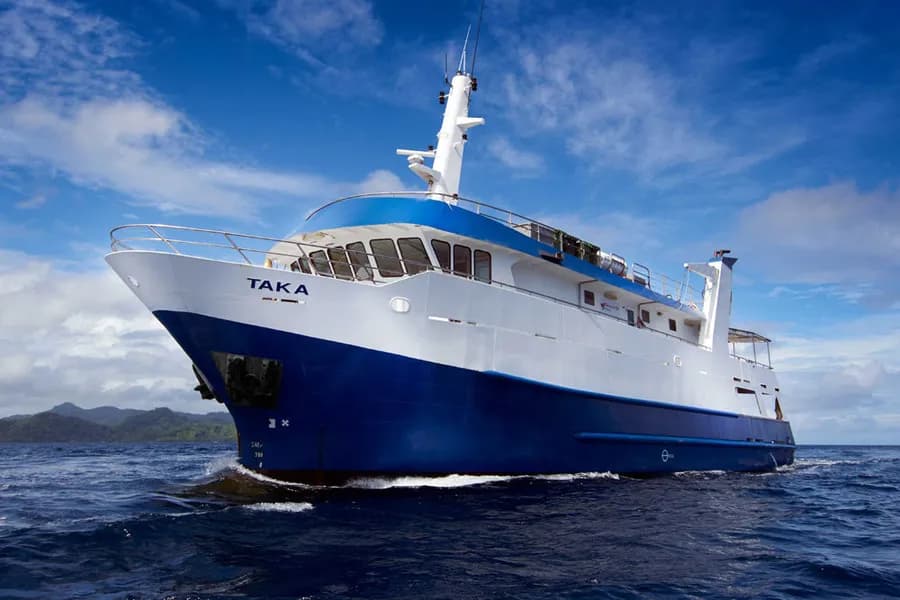
With a tumultuous and controversial history, Bikini Atoll is the ultimate far-flung dive destination, offering phenomenal wrecks, exceptional marine life, and a tantalizing air of mystery. Scuba diving in Bikini Atoll is at the pinnacle of many a serious wreck divers underwater careers, and the challenge of reaching this UNESCO World Heritage Site makes it all the more alluring.
Scuba Dive Level
Technical Diver
Visibility
80 to 164 feet (24 to 50 meters)
Average Water Temperature
83
Wreck Diving
Shark Encounters
Diving Bikini Atoll is only suitable for divers with a technical certification.
With a tumultuous and controversial history, Bikini Atoll is the ultimate far-flung dive destination, offering phenomenal wrecks, exceptional marine life, and a tantalizing air of mystery. Scuba diving in Bikini Atoll is at the pinnacle of many serious wreck divers' underwater careers, and the challenge of reaching this UNESCO World Heritage Site makes it all the more alluring.
Bikini Atoll is only accessible via two liveaboard operators, Truk Master and Indies Trader.
One of the most northerly atolls of the Marshall Islands, Bikini Atoll sits in the Central Pacific Ocean approximately 2,650 miles west of Hawaii. The atoll itself is made up of 23 separate coral islands surrounding a central lagoon and is notorious as the site of over two dozen nuclear tests that were carried out by the US Government in the 40s and 50s.
After the island's original residents were evacuated in 1946, several attempts to recolonize Bikini over the succeeding decades proved unsuccessful. Finally, in 1996, the Bikini Council approved diving as a potential source of income for future resettlement attempts, and for a while, a shore-based dive operation offered a realistic alternative to visiting via liveaboard. However, cancellation of the atolls only flight service in 2008 led to the inevitable closure of all land-based tourist facilities, and today only a handful of caretakers reside on Bikini Atoll.
For wreck-diving enthusiasts, Bikini Atoll is now one of the most intriguing ship graveyards on the planet, with a so-called nuclear fleet of 21 military wrecks offering exceptional diving in a pristine lagoon ecosystem. Minimal human interference during the last 70 years has allowed marine life not only to recover from the effects of radiation, but to flourish unhindered by fishing, pollution, and other human factors. A plethora of reef species attracts pelagic gamefish such as dogtooth tuna, barracuda and giant trevally, as well as huge numbers of grey reef sharks.
Against all odds, the marine life around Bikini Atoll is abundant with huge coral heads, hundreds of schools of fish, and a thriving ecosystem of the smallest reef fish through to large pelagic visitors. Research suggests that coral started to regenerate as soon as 10 years after the initial nuclear blasts, and a lack of human interference has allowed marine life to recolonize to its full potential.
Every wreck is covered in rope and soft corals, providing habitat for massive shoals of glittering glassfish and aggregations of marbled grouper and coral trout. These fish, in turn, are prey for larger game fish such as tuna, snapper, barracuda, and trevally. Sharks abound in these waters, with numerous species including gray reef, silvertip, blacktip, whitetip, Indo-Pacific lemon, and even Galapagos sharks making an appearance in the sheltered waters of the inner lagoon. On the outer side of the reef, even more gray reef and blacktip sharks can be found, as well as silky, oceanic whitetips, and the occasional hammerhead shark.
However, it is the armada of eerie wrecks that is undoubtedly the main attraction, with the remains of the famous aircraft carrier USS Saratoga, numerous other US military ships, as well as a couple of German and Japanese warships, all providing some of the best wreck diving in the world.
With average dive depths of 164 feet (50m) and bottom times upwards of 100 minutes, Bikini Atoll is only suitable for technically trained divers. Liveaboards require guests to hold a TDI Advanced Nitrox & Decompression Procedures, PADI Tec 50, or other equivalent certification.
A typical dive schedule involves two dives a day with a minimum 4-hour surface interval between. The second dive of the day tends to be a shallower penetration dive, often on the Saratoga, to reduce decompression times. Despite these challenging profiles, diving in Bikini is extremely comfortable, boasting warm water, excellent visibility, and no current or surge.
It is generally accepted that latent radiation poses minimal risk to divers as water is an excellent insulator. Touching or handling artifacts is forbidden, therefore there should be no risk of contamination.
The best example of only three diveable aircraft carrier wrecks in the world, the USS Saratoga sits upright in 59 to 164 feet (18 to 50m) of water and is the piece de resistance of Bikini Atoll. With a flight deck over 885 feet (270m) long, several dives are needed to explore and fully appreciate this magnificent vessel. She was armed and loaded in preparation for the nuclear tests, and so countless planes, bombs, and military equipment, as well as everyday items such as plates and bowls, tools, and general stores, are strewn throughout her vast and complex superstructure. In particular, the sick-bay, complete with dentist chair in situ, is an intriguing find.
Often the first dive of a trip to Bikini, the Prinz Eugen sits off Ebeye Island in Kwajalein Atoll and is used as a check dive. This German heavy cruiser sank in 1946 several months after the initial nuclear tests, and now rests upside down at 124 feet (38m), with one of her props breaking the surface. At 682 feet (208m) long, there are plenty of nooks and crannies, and some reasonable penetration to get divers warmed up for the main event.
The pride of the Japanese fleet, battleship HIJMS Nagato was seized by the US at the end of WWII and eventually succumbed to the second test blast at Bikini. At 725 feet (221m) long, swimming the length of her upturned keel is an exceptional experience, passing her bridge protruding 98 feet (30m) out into the sand before venturing under the bow to discover her two imposing 16-inch guns.
Another vessel lying keel-up in 177 feet (54m) of water, this battleship displays some of the worst damage from the nuclear blasts, her 12-inch armor plates concertinaed like foil around the hulls supporting steels.
An outstanding wreck that sits upright and close to the reef she hit as she sank. While her mainmast, stack, bridge, and parts of the top superstructure were ripped off by the first test, guns and torpedo tubes remain in their mounts, and depth charges can be spotted still on their twisted tracks.
Every wreck at Bikini Atoll would be a stand-out dive if located on its own anywhere else; combined, these wrecks offer an overwhelming range of options, and divers are spoiled for choice on a two-week trip. These are the best of the rest:
Somewhat of a novelty dive, but not to be missed if time and conditions permit, the outer wall of the atolls southwestern corner is teeming with sharks, providing an exciting change of scene. Hundreds of gray reef and silvertip sharks slice through the top few meters of water, alongside tuna, jacks, and massive Napoleon wrasse.
Check out our guide to the best shark dive destinations in the world.
Liveaboards visit Bikini from May through to October, spending the second half of the year in Truk Lagoon. As a tropical destination, the Marshall Islands enjoy fairly constant temperatures, however November to April is cyclone season, and tropical storms can bring wind, rain, and choppy surface conditions.
The journey to Bikini Atoll is an adventure in itself, involving several days of travel, flights, and transfers.
From the US and Europe, fly internationally to Hawaiis Daniel K. Inouye International Airport (HNL) and overnight in Honolulu before catching the morning United Airlines flight (via Majuro) to Bucholz Army Airfield (KWA) on Kwajalein Atoll.
From Australia and Asia, fly internationally to Hawaii and on to Kwajalein as above, or fly to Antonio B. Won Pat International Airport (GUM) on Guam, changing in Manila (MNL) or Tokyo (NRT/HND). Once in Guam, take the lengthy island hopper flight through Micronesia to Kwajalein Atoll.
Kwajalein Atoll is a US Military base, and so divers are required to present a confirmation letter from their liveaboard to be allowed entry. Army transport will then transfer visitors on the 10-minute journey to the boat embarkation point on Ebeye Island.
The journey out to Bikini Atoll takes 24 to 30 hours, allowing plenty of time to set up equipment, enjoy a presentation on the history of the atoll, and recover from jet lag.
Bikini Atoll is a liveaboard-only destination, and the remote location and complexity of logistics mean only a couple of boats run trips here. Boats tend to run 10- to 14-day trips, either solely to the atoll, or in combination with other Marshall Island destinations.
Guest numbers are generally limited to 10 or 12 divers to allow room for extra equipment and additional safety considerations.
While liveaboard trips dont offer many options for additional activities, snorkeling is often available between dives. It is also possible to go ashore some evenings and spend some time in the old resort bar. A land tour of some of the military installments is a fascinating break from diving, and visitors can view some experimental vegetable crops where scientists are measuring the ongoing effects of radiation.
Some visitors opt to spend some time in the capital of the Marshall Islands, Majuro, either before or after their trip. As well as excellent reef diving, kiteboarding and surfing are also popular activities.

Explore Bikini Atoll
